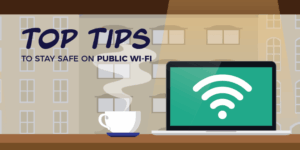
Free Wi-Fi is available almost everywhere we go. From coffee shops and airports to hotels and public transport, connecting to a free Wi-Fi network has become second nature. However, despite frequent warnings about security risks, millions of people continue to use public Wi-Fi every day without considering the potential consequences.
So, are public Wi-Fi networks really that dangerous? In short, yes. Research shows that 87% of internet users have put their personal information at risk while using free public Wi-Fi. This relaxed attitude towards online security places users directly in the sights of cybercriminals and significantly increases the likelihood of falling victim to cybercrime.
There are two main types of public Wi-Fi networks: secured and unsecured. Secured networks usually require users to accept legal terms, register an account or enter a password before connecting.
Unsecured Wi-Fi networks, on the other hand, do not require passwords or login credentials. These open networks often lack encryption, making it much easier for attackers to intercept data and compromise connected devices.
Regardless of the network type, public Wi-Fi environments present multiple weak points. Opportunistic hackers actively monitor these networks, ready to exploit any lapse in security to launch targeted attacks.
What Are the Dangers of Public Wi-Fi?
- Man-in-the-Middle (MITM) attacks
A Man-in-the-Middle attack occurs when a third party secretly intercepts communication between your device and the server you are connected to. Hackers can monitor your online activity and steal sensitive information such as usernames, passwords, credit card details and PINs.
- Malware
Malware spreads easily across unsecured Wi-Fi networks. Once installed, it can spy on your activity, steal personal or financial data, or even use your device to attack other systems. In some cases, attackers compromise the Wi-Fi access point itself and display fake pop-ups offering “software updates” that actually install malware.
- Wi-Fi sniffing
Wi-Fi sniffing allows hackers to monitor network traffic using specialised tools. This enables them to view visited websites and, in some cases, capture login credentials and other sensitive data transmitted over the network.
Top Tips to Stay Safe on Public Wi-Fi
1. Use a VPN
A Virtual Private Network (VPN) is one of the most effective ways to stay safe on public Wi-Fi. A VPN encrypts your internet traffic, creating a secure tunnel that prevents hackers from seeing your activity or location.
2. Use HTTPS websites
When a VPN is unavailable, always browse websites using HTTPS connections. The “S” stands for secure and means that communication between your browser and the website is encrypted. If your browser displays a “Not Secure” warning, leave the site immediately.
3. Turn off file sharing
Disable file sharing to prevent others on the same network from accessing your files. This setting can usually be adjusted through your system preferences or control panel. Windows users should select the “public network” option when connecting to unfamiliar Wi-Fi.
4. Enable your firewall
A firewall monitors incoming and outgoing network traffic and blocks suspicious activity. While it does not offer complete protection, enabling your firewall adds an important layer of defence when using public Wi-Fi.
5. Keep security software updated
Up-to-date antivirus software helps detect threats and prevent unauthorised access. Regular updates are essential, as outdated software often contains vulnerabilities that hackers actively exploit.
6. Avoid financial transactions
Never access online banking or make payments over public Wi-Fi. Sharing personal details such as your address or date of birth is equally risky, as this information can be intercepted and used for identity theft.
7. Enable two-factor authentication
Two-factor authentication adds an extra verification step, such as a one-time code or biometric check. Even if your password is compromised, attackers will not be able to access your account without the second factor.
8. Turn off Wi-Fi when not in use
When you are finished browsing, turn off Wi-Fi completely. Even when not actively connected, devices can still communicate with nearby networks. This simple habit improves security and conserves battery life.
Learn More About MetaCompliance Solutions
Understanding public Wi-Fi security risks is a vital step in protecting your organisation and employees from modern cyber threats. MetaCompliance helps businesses reduce human cyber risk through industry-leading cyber security awareness training, ensuring users have the knowledge and skills to stay safe on public networks and beyond.
Explore our comprehensive suite of solutions designed to strengthen cyber resilience, minimise human risk and improve overall security posture. Our Human Risk Management Platform includes:
- Automated Security Awareness
- Advanced Phishing Simulations
- Risk Intelligence & Analytics
- Compliance Management
To discover how these solutions can help protect your organisation from public Wi-Fi risks and other cyber threats, contact us today to book a demo.
Wi-Fi Security Risks FAQs
What are Wi-Fi security risks?
Wi-Fi security risks include data interception, malware infections and unauthorised access to your device when using unsecured networks.
Why is public Wi-Fi dangerous?
Public Wi-Fi networks often lack encryption, making it easier for hackers to monitor activity and steal sensitive information.
Can hackers see my data on public Wi-Fi?
Yes, attackers can intercept data such as login details, emails and browsing activity on unsecured networks.
How can I reduce Wi-Fi security risks?
Use a VPN, enable your firewall, avoid financial transactions and keep your security software updated.